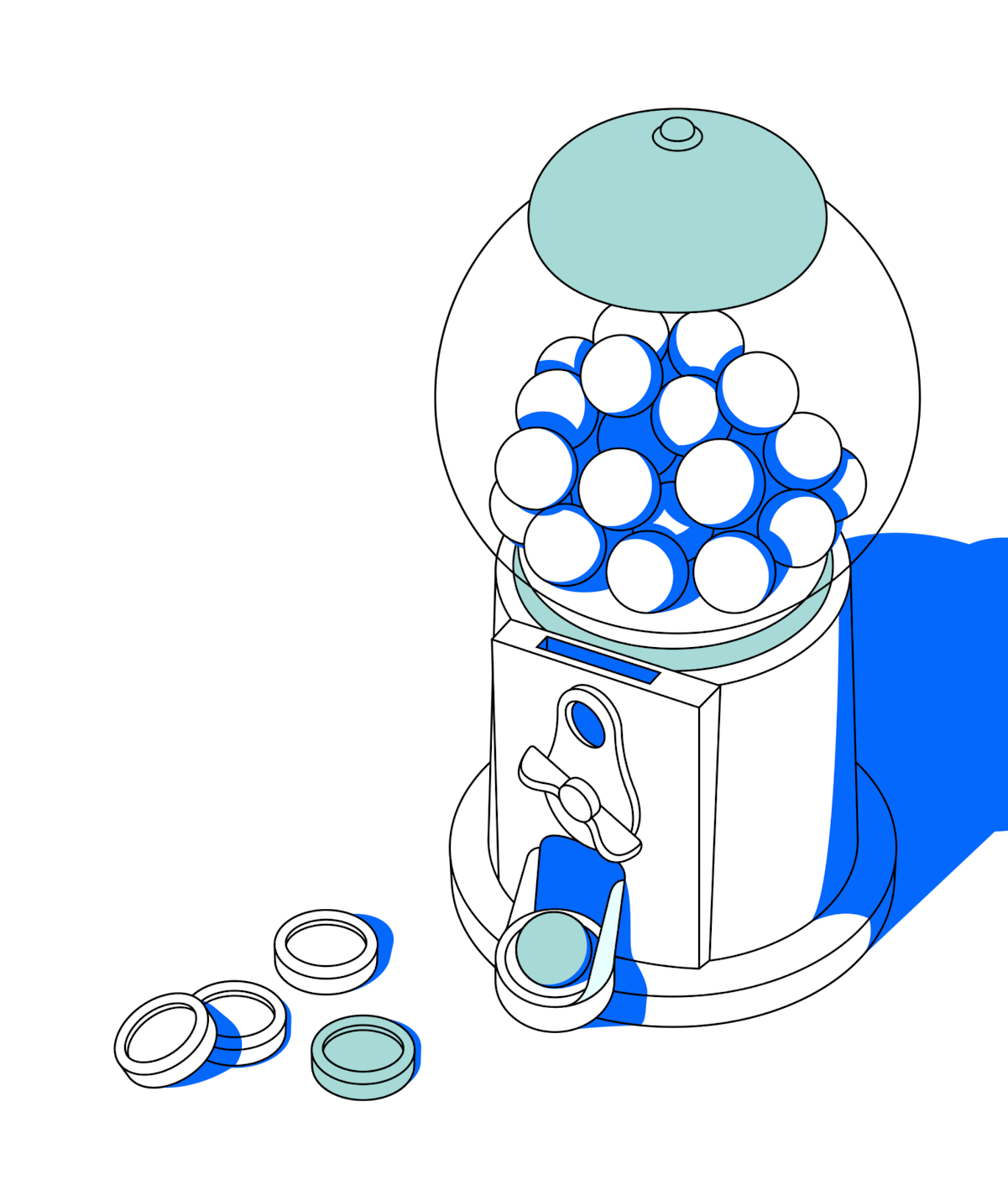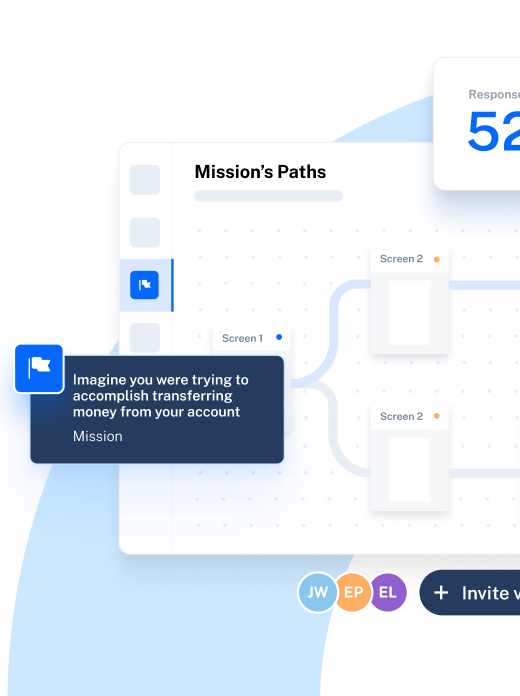TL;DR
Securing stakeholder buy-in for UX research involves empathy, clear storytelling, and a strong understanding of business objectives. Lead with impact, show how research connects to ROI, retention, and risk reduction, and present findings as a story using the Pyramid Principle.
Visuals like heatmaps, prototypes, and user clips make insights tangible, while empathy helps address common objections around cost, time, and value. Collaboration is key: involve teams early, share results openly, and make research a shared responsibility.
UX research can be challenging enough without feeling like you’re fighting for budget and buy-in. By bringing stakeholders on board, you release user research from operating in a vacuum, so everyone in the organization can benefit from customer insights and, ultimately, build better products.
In this article, we share six practical ways to help you demonstrate the impact of UX research and secure lasting stakeholder buy-in.
Why do you need stakeholder buy-in for UX research?
Stakeholder buy-in is crucial to secure resources, support, and team alignment for your proposed UX research strategy or project. Without stakeholder buy-in, UX researchers struggle to conduct user research projects effectively and spread the value of user insights. At worst, the research function in an org can come to a total standstill.
Stakeholder buy-in is vital across multiple dimensions:
- Project-by-project basis: Buy-in for individual UX research studies helps secure budget, support launches, and drive cross-team engagement with the insights shared
- Research strategy and wider research function: Support for an overarching UX research strategy is critical for resource allocation, navigating red tape or budgeting issues, and democratizing research across the organization
- Interdepartmental alignment: Stakeholders are key to cultivating a user-centered culture and data-informed approach to UX design and decision-making across the org.
Despite the need for stakeholder buy-in in UX research being crystal clear, it can be tough to get that much-needed approval and budget from up top. So, what are you up against?
Building a culture of learning comes directly from leadership. If you don’t have leaders who consistently prioritize being connected to customers, learning from them, and baking that into how the organization operates, no one else will be incentivized to do it.

Roy Opata Olende
UX Research & Research Ops Leader
Why is getting stakeholder buy-in hard?
Given the benefits, we wouldn��’t blame you for wondering why stakeholders aren’t lining up to make UX research an integral part of their product development process.
While each company is unique, with their own reasoning behind stakeholder decisions, some of the main barriers to stakeholder buy-in include:
- UX research is misunderstood: Without transparent UX research processes and work to evangelize research, it’s easy to dismiss its value. Drawing clear lines from research to profit is challenging, so highlighting the impact of UX research via its connection to product decision-making and user results is crucial.
- Reluctance due to expenses: Many stakeholders don’t want to invest in UX research as it’s expensive. Demonstrating that its long-term benefits outweigh the cost is key to winning support.
- Uncertainty about the outcomes: UX research doesn’t provide instant answers, which is why stakeholders may hesitate to invest without visible short-term gains.
Buy-in can be difficult—but it’s by no means impossible. Let’s get into how you can win the investment your UX work deserves.
6 Expert tips on how to get stakeholder buy-in for user research
Here’s how to convince stakeholders in UX research
1. Build a narrative and story
Start by crafting your research presentation as a story, not a report. Stakeholders connect better when they can follow a clear thread from the problem to the solution. A strong narrative helps you move beyond presenting data to highlighting impact.
When sharing your insights, lead with the ‘so what’. Stakeholders have limited time, so start with what matters most: the key findings and their business impact. Once you’ve secured their attention, build context around how you reached those insights and what they mean for the product.
This top-down structure follows the Pyramid Principle, a reporting method that starts with your conclusion, then moves into supporting insights, and finally, the evidence or data behind them. In other words: tell them the point, explain why it matters, and then show how you know. It’s a simple shift that makes your findings clearer and easier to act on.
Once your key message is clear, structure your story around three parts:
- Highlight the problem: Begin with a business problem your team is facing. It can be anything from increased churn to customer dissatisfaction. Highlight the problems users have with the product and how it impacts wider business objectives.
- Tell them how UX research can save the day: Weave the narrative to showcase how research is necessary to gain insights on user experience, including pain points, expectations, and perspectives. Show stakeholders the surveys or other UX research methods you’ll use to delve into the problem.
- Present the solution: Present stakeholders with specialized UX reports, and illustrate how the resulting UX research insights can inform product design decisions. Show how implementing those changes serves as a solution for your outlined problem, and explore the knock-on business impact.
Geoffrey Crofte, Senior UX Lead Designer at Foyer Group, suggests testing out your story with colleagues before presenting it to stakeholders:
“To make a consistent story, you need a good mix between facts and vision. The advice I try to keep for myself is this one: if you can tell a good story and get buy-in from non-research colleagues, you’re on the right path.”
2. Show the right data
When making decisions, your stakeholders have several priorities in mind. Executives care about the why behind the numbers, like ROI, risk mitigation, customer retention, and cost savings. Your job isn’t to show everything you’ve uncovered; it’s to show the data that connects user insights to business outcomes.
Effective UX reporting bridges that gap. It organizes findings in a way that connects user experience metrics to outcomes that leaders track. With Maze, reports are generated automatically as part of your research workflow, turning usability data into clear, shareable insights your stakeholders can act on:
- Usability Score: A simple, quantifiable measure of product performance based on success rate, misclick rate, and average time to complete a task
- Mission analysis: A breakdown of where users succeed or struggle, showing potential revenue risks and opportunities for cost reduction by preventing friction early
- Optimal path analysis: Clear visualizations of where users drop off or complete a journey successfully, letting you frame design changes as risk mitigation strategies
- Open-ended feedback and highlighted quotes: Real user comments you can star and showcase directly in your report ideal for showcasing customer sentiment, loyalty, and brand impact.
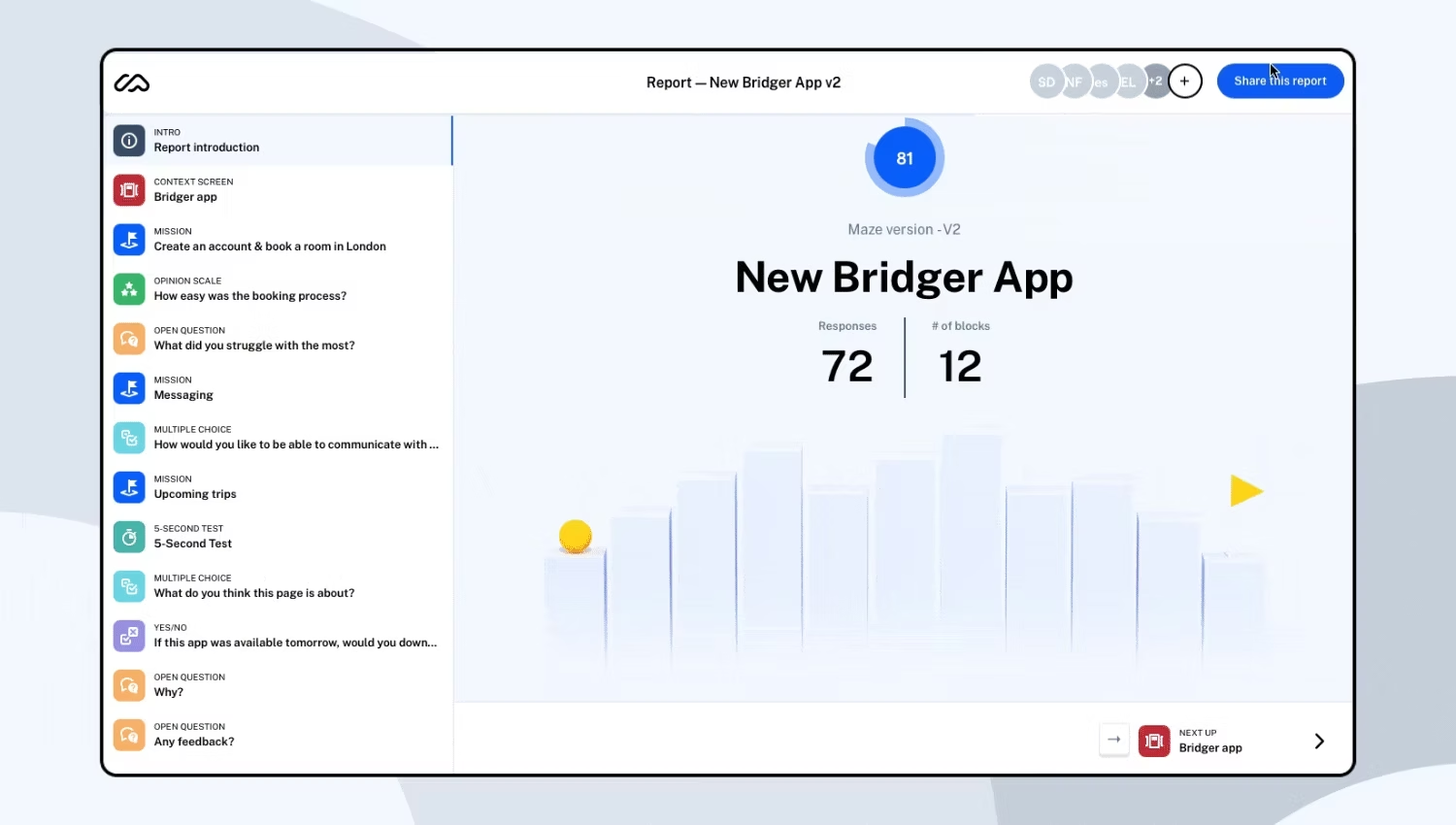
Sharing reports with Maze
Geoffrey emphasizes the power of speaking to stakeholder motivation:
“You need to do your job the best you can, but also understand what motivates your stakeholders (money is obvious, but what else?). Demonstrate the benefits for the end users, yes, but also speak to the stakeholders’ motivations to get buy-in.”
Both you and your stakeholders are working towards shared goals of better products and fulfilling wider business objectives. It’s just a matter of putting it in their terms. Speaking directly to stakeholder interests and showing them how UX research can help navigate uncertainty and achieve success is crucial for securing buy-in.
💡This is crucial for effectively moving through the five stages of research maturity. Many organizations get stuck at level three, where research begins early but lacks major influence over wider business decisions.
To move towards level four and five—where research informs roadmaps and is tied to business outcomes—you need to make research relevant to stakeholders and the business.
For example:
- “This onboarding step confuses users” → “…which may explain why we lose 22% of signups at Step 2.”
- “This language breaks trust” → “…which is risky given our enterprise push.
Want to find out more? Take the Research Maturity Quiz to find out where your organization currently sits on the research maturity scale.
3. Find the right format
Choosing how to present your findings is just as important as the findings themselves. Your goal is to meet stakeholders where they are. A live presentation works best when you need to align quickly, influence direction, or build momentum for a decision. A UX research report, on the other hand, is ideal for documenting evidence, creating an ongoing reference point, or sharing findings asynchronously across teams.
Here’s how to decide which format fits your context:
- Live presentation: Use this when you’re presenting to a smaller group of decision-makers or when timing is critical. For example, before a design sprint or roadmap planning session. Lead with your key takeaways, highlight key points from your Maze Report (such as usability scores or success metrics), and keep the discussion focused on the business implications. You can present your findings in a 15-minute research session, highlighting how solving a particular usability issue could boost conversion by 20%.
- Written report or shareable link: Use this when your audience is larger, global, or unable to attend live sessions. Maze Reports makes this simple. You can share an interactive link with all stakeholders, add comments, or export a PDF for leadership reviews. This format is especially useful for teams that want to revisit insights over time.
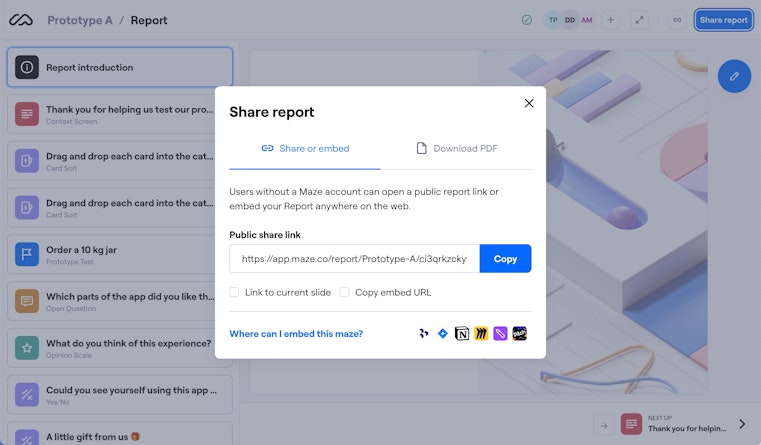
- Hybrid approach: Often, the most effective option is to present live for alignment, then share the report for follow-up. Use the live session to tell the story and the written report to keep your evidence accessible and actionable.
4. Anticipate and address stakeholder pains and worries
Even with a clear story and data-driven insights, expect pushback. Stakeholders have their own goals, pressures, and constraints, from budget limits to product timelines. The key is empathy: if you can anticipate their objections and address them upfront, you’ll gain credibility fast.
Here’s how you can reframe common concerns into opportunities for alignment:
Every organization has its own version of these concerns, so tailor your responses to your context. You might even run quick stakeholder interviews to identify recurring worries before big research cycles.
5. Show, don't tell
A picture’s worth a thousand words. It turns talk into tangible examples of UX success. Instead of simply telling stakeholders that UX research will solve their problems and produce better business outcomes, show them. Aim for case studies with wireframes, prototypes, storyboards, and visual data representations—everything you need to walk stakeholders through how UX research gets results.
Present UX research findings and visuals that make insights real: wireframes, prototypes, storyboards, and data visualizations that walk stakeholders through how UX research delivers results.
- Show process: Share how user insights informed design changes. Walk through key decisions and highlight the before and after effect on usability or satisfaction
- Show evidence: Use clips from usability sessions to illustrate pain points, like a user hesitating or misclicking on a critical step. Then follow up with how that feedback shaped design improvements that boosted task success or retention
- Show outcomes: Present metrics or case studies from similar teams. For example, highlight how another Product team reduced churn by simplifying onboarding after targeted usability testing.
If you’re already running research operations, show stakeholders what you’ve been working on. Present final designs, key user insights that informed design decisions, and the processes that got you there.
With Maze, it’s simple to build these kinds of visual-driven stories. Each project generates a shareable report with usability testing scores, heatmaps, and screen-level insights, perfect for adding screenshots, Clips, or quotes from user interviews directly into presentations. You can also highlight the exact points where users struggled, annotate key learnings, and let the visuals speak for themselves.

💡 Looking for some statistics to help win-over stakeholders? These 30+ UX statistics prove the value of UX for organizations big and small.
6. Make research discussions collaborative
Getting stakeholder buy-in is a collective practice. Modern UX research thrives on collaboration, and bringing others into the process is one of the most effective ways to build trust and influence.
Start by inviting team members who already understand the value of user insights—designers, PMs, marketers, and developers—and make them visible champions of research.
You can:
- Run internal pilot projects: Launch small studies and invite cross-functional partners to observe. Seeing real users interact with designs firsthand builds instant empathy
- Leverage your research repository: Use existing studies to show how research has informed decisions across teams—from simplifying support flows to refining marketing copy
- Encourage async participation: Share clips, highlights, or key insights in Slack or team docs so busy stakeholders can comment and engage on their own time
- Create co-ownership: Ask collaborators to present sections of findings in team meetings, showing that research belongs to everyone
If you’re using a collaborative research platform like Maze, invite stakeholders directly into research discussions. They can view results, comment on insights, or react to user session clips, making research visible and participatory.
As UX researcher, Geoffrey Crofte, notes:
“The best way to start is with an internal pilot project. Find allies who know how the political stuff works, and what strings you need to pull—then ask them to get involved from their own position.”
Keep in mind to look for allies high and low. You’ll find developers, product managers, and marketers who are all on board with using user research to build organizations that learn.
Presenting UX research findings and proving its value with Maze
Getting stakeholder buy-in can be challenging, but it’s possible with the right preparation, empathy, and storytelling. Once you’ve won that support, the next step is proving research impact continuously.
That’s where Maze helps you turn insight into influence. Every study you run in Maze automatically generates a visual-rich report that’s easy to share and simple to understand. Heatmaps, usability scores, and screen-level insights transform findings into a clear story stakeholders can see at a glance. Instead of long summaries, you can walk teams through where users click, where they get stuck, and how design changes drive measurable improvements.
When your insights are easy to see, discuss, and act on, you prove the value of UX research.
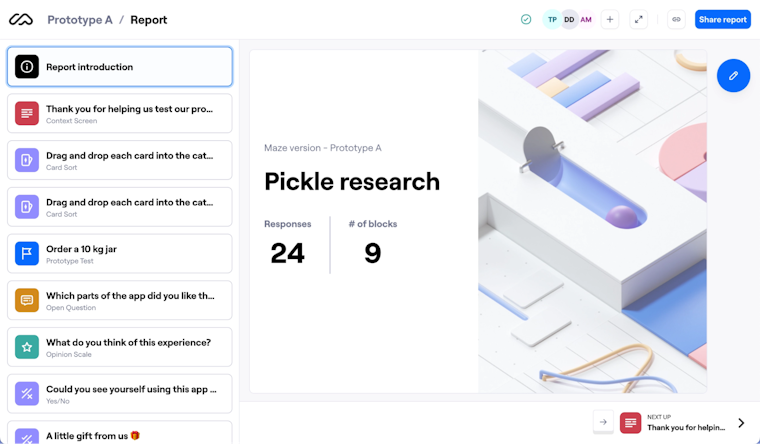
Frequently asked questions about how to get stakeholder buy-in
What is stakeholder buy-in?
What is stakeholder buy-in?
Stakeholder buy-in is the process of getting approval and support from stakeholders for a project or initiative. It involves convincing stakeholders of the value of a project so that they support it, provide the necessary resources, and help with overcoming obstacles.
Who are the stakeholders in user research?
Who are the stakeholders in user research?
In user research, stakeholders include anyone who has an interest or is impacted by the design of the product or service. This includes product managers, designers, developers, and executives and senior management.
What data should I include when reporting UX research to stakeholders?
What data should I include when reporting UX research to stakeholders?
Include only what connects user insights to business outcomes. Focus on usability metrics (such as task success, completion time, and error rate), customer sentiment, and any data that links design improvements to measurable results, including conversion, retention, or cost reduction. Avoid overwhelming detail; lead with the insights that matter most to decision-making.
How to make UX research findings more persuasive for executives?
How to make UX research findings more persuasive for executives?
To make your findings resonate with leadership, focus on outcomes:
- Lead with impact: Start by explaining how research results affect revenue, retention, or customer satisfaction
- Show, don’t tell: Use visuals like heatmaps, usability scores, or short user clips to make data tangible
- Connect insights to KPIs: Translate findings into measurable outcomes such as reduced churn, faster task completion, or fewer support requests
- Keep it concise: Avoid research jargon and summarize what matters in one slide or sentence per key takeaway
How can Maze help simplify stakeholder reporting and buy-in?
How can Maze help simplify stakeholder reporting and buy-in?
Maze automatically turns research into visual, shareable reports that highlight key metrics like usability scores, success rates, and user behaviors. You can present insights live or share interactive reports for async review, helping stakeholders see results, comment directly, and align on next steps.



